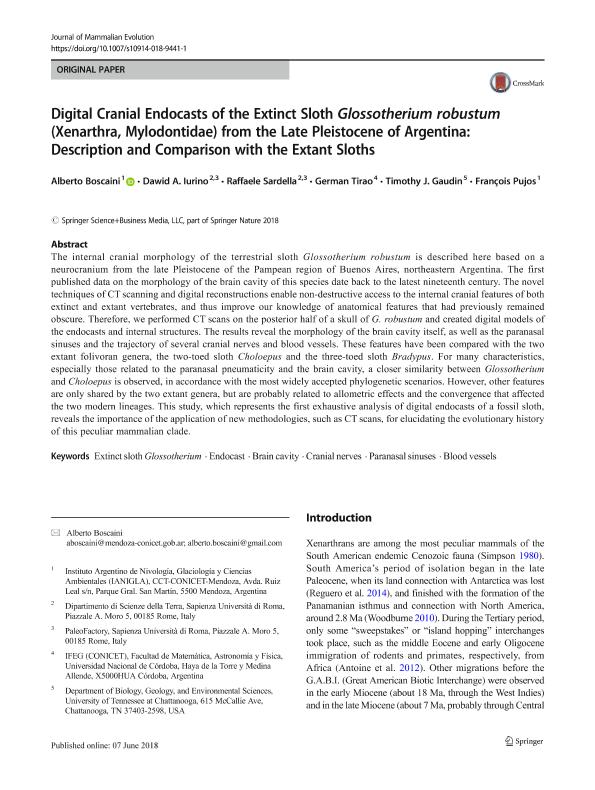Mostrar el registro sencillo del ítem
dc.contributor.author
Boscaini, Alberto

dc.contributor.author
Iurino, Dawid A.
dc.contributor.author
Sardella, Raffaele
dc.contributor.author
Tirao, German Alfredo

dc.contributor.author
Gaudin, Timothy

dc.contributor.author
Pujos, François Roger Francis

dc.date.available
2019-10-24T21:38:05Z
dc.date.issued
2018-06
dc.identifier.citation
Boscaini, Alberto; Iurino, Dawid A.; Sardella, Raffaele; Tirao, German Alfredo; Gaudin, Timothy; et al.; Digital Cranial Endocasts of the Extinct Sloth Glossotherium robustum (Xenarthra, Mylodontidae) from the Late Pleistocene of Argentina: Description and Comparison with the Extant Sloths; Springer; Journal of Mammalian Evolution; 6-2018; 1-17
dc.identifier.issn
1064-7554
dc.identifier.uri
http://hdl.handle.net/11336/87295
dc.description.abstract
The internal cranial morphology of the terrestrial sloth Glossotherium robustum is described here based on a neurocranium from the late Pleistocene of the Pampean region of Buenos Aires, northeastern Argentina. The first published data on the morphology of the brain cavity of this species date back to the latest nineteenth century. The novel techniques of CT scanning and digital reconstructions enable non-destructive access to the internal cranial features of both extinct and extant vertebrates, and thus improve our knowledge of anatomical features that had previously remained obscure. Therefore, we performed CT scans on the posterior half of a skull of G. robustum and created digital models of the endocasts and internal structures. The results reveal the morphology of the brain cavity itself, as well as the paranasal sinuses and the trajectory of several cranial nerves and blood vessels. These features have been compared with the two extant folivoran genera, the two-toed sloth Choloepus and the three-toed sloth Bradypus. For many characteristics, especially those related to the paranasal pneumaticity and the brain cavity, a closer similarity between Glossotherium and Choloepus is observed, in accordance with the most widely accepted phylogenetic scenarios. However, other features are only shared by the two extant genera, but are probably related to allometric effects and the convergence that affected the two modern lineages. This study, which represents the first exhaustive analysis of digital endocasts of a fossil sloth, reveals the importance of the application of new methodologies, such as CT scans, for elucidating the evolutionary history of this peculiar mammalian clade.
dc.format
application/pdf
dc.language.iso
eng
dc.publisher
Springer

dc.rights
info:eu-repo/semantics/openAccess
dc.rights.uri
https://creativecommons.org/licenses/by-nc-sa/2.5/ar/
dc.subject
BLOOD VESSELS
dc.subject
BRAIN CAVITY
dc.subject
CRANIAL NERVES
dc.subject
ENDOCAST
dc.subject
EXTINCT SLOTH GLOSSOTHERIUM
dc.subject
PARANASAL SINUSES
dc.subject.classification
Paleontología

dc.subject.classification
Ciencias de la Tierra y relacionadas con el Medio Ambiente

dc.subject.classification
CIENCIAS NATURALES Y EXACTAS

dc.subject.classification
Biología

dc.subject.classification
Ciencias Biológicas

dc.subject.classification
CIENCIAS NATURALES Y EXACTAS

dc.title
Digital Cranial Endocasts of the Extinct Sloth Glossotherium robustum (Xenarthra, Mylodontidae) from the Late Pleistocene of Argentina: Description and Comparison with the Extant Sloths
dc.type
info:eu-repo/semantics/article
dc.type
info:ar-repo/semantics/artículo
dc.type
info:eu-repo/semantics/publishedVersion
dc.date.updated
2019-10-17T13:42:25Z
dc.identifier.eissn
1573-7055
dc.journal.pagination
1-17
dc.journal.pais
Alemania

dc.description.fil
Fil: Boscaini, Alberto. Consejo Nacional de Investigaciones Científicas y Técnicas. Centro Científico Tecnológico Conicet - Mendoza. Instituto Argentino de Nivología, Glaciología y Ciencias Ambientales. Provincia de Mendoza. Instituto Argentino de Nivología, Glaciología y Ciencias Ambientales. Universidad Nacional de Cuyo. Instituto Argentino de Nivología, Glaciología y Ciencias Ambientales; Argentina
dc.description.fil
Fil: Iurino, Dawid A.. Università degli studi di Roma "La Sapienza"; Italia
dc.description.fil
Fil: Sardella, Raffaele. Università degli studi di Roma "La Sapienza"; Italia
dc.description.fil
Fil: Tirao, German Alfredo. Consejo Nacional de Investigaciones Científicas y Técnicas. Centro Científico Tecnológico Conicet - Córdoba. Instituto de Física Enrique Gaviola. Universidad Nacional de Córdoba. Instituto de Física Enrique Gaviola; Argentina
dc.description.fil
Fil: Gaudin, Timothy. University of Tennessee; Estados Unidos
dc.description.fil
Fil: Pujos, François Roger Francis. Consejo Nacional de Investigaciones Científicas y Técnicas. Centro Científico Tecnológico Conicet - Mendoza. Instituto Argentino de Nivología, Glaciología y Ciencias Ambientales. Provincia de Mendoza. Instituto Argentino de Nivología, Glaciología y Ciencias Ambientales. Universidad Nacional de Cuyo. Instituto Argentino de Nivología, Glaciología y Ciencias Ambientales; Argentina
dc.journal.title
Journal of Mammalian Evolution

dc.relation.alternativeid
info:eu-repo/semantics/altIdentifier/doi/http://dx.doi.org/10.1007/s10914-018-9441-1
dc.relation.alternativeid
info:eu-repo/semantics/altIdentifier/url/https://link.springer.com/article/10.1007%2Fs10914-018-9441-1
Archivos asociados
